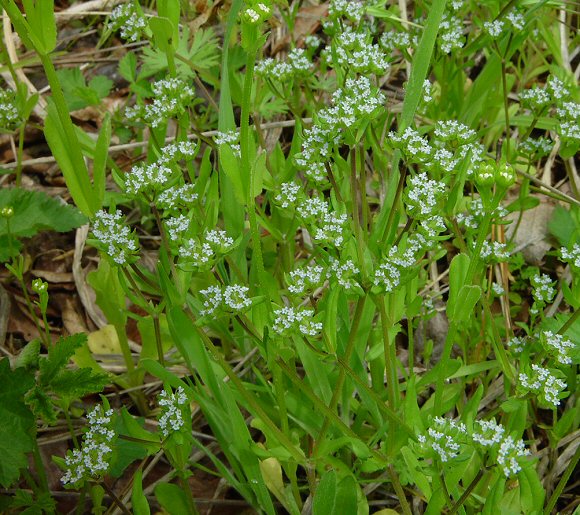Valerianella locusta (L.) Laterr.
Corn Salad

Introduced
CC = *
CW = 5
MOC = 7
© SRTurner
Valerianella locusta (L.) Laterr.Corn Salad | |
 |
Introduced CC = * CW = 5 MOC = 7 |
© SRTurner |
|
Family - Valerianaceae Stems - Ascending to erect, 8-35 cm long, multiple from the base, dichotomously branching, herbaceous, from a single thin taproot and fibrous roots, retrorse pubescent, 4-angled. Internodes with shallow thin vertical grooves arising at the leaf bases.
Leaves - Opposite, simple, sessile. Basal leaves in a rosette, spatulate, to 8 cm long, 2 cm broad, entire, glabrous or with very sparse appressed pubescence, rounded at the apex. Stem leaves with the blades 1-8 cm long, the margins entire or less commonly few-toothed near the base, lanceolate to lance-oblong, reduced upward, rounded at the apex, glabrous.
Inflorescences - Terminal clusters of flowers. Bracts and bractlets with short, nonglandular, bristly hairs along the margin. Bracts oblong, quite small in flower but quickly expanding to 3 mm long, 1-1.5 mm broad, 2 per each flower. Flowers sessile.
Flowers - Corollas funnelform, 5-lobed, 1.5-4.0 mm long, the tube shorter than to about as long as the expanded upper portion (limb and lobes), pale blue, glabrous. Corolla lobes spreading, rounded at the apex, 0.7 mm long, 0.6 mm broad. Stamens 3, adnate at the apex of the corolla tube, included in the corolla or only slightly exserted. Filaments glabrous, 0.8 mm long, translucent-blue. Ovary inferior, 3-locular, green, expanded at the apex on one side, 1 mm long in flower, quickly inflating in fruit to 2 mm.
Fruits - Achenelike, 1.9-2.3 mm long, oblong-elliptic to ovate in dorsal view, glabrous, minutely hairy, or sparsely bristly-hairy, the fertile locule much wider than the sterile ones, with a dome-shaped corky mass on the back, smooth or at most with a fine nerve or slight ridge, the sterile locules more or less parallel, with a shallow, narrow, relatively inconspicuous groove between them. Flowering - April - May. Habitat - Bottomland forests, crop field margins, fallow fields, roadsides. Origin - Native to Europe. Lookalikes - Valerianella radiata, which is far more common in Missouri. Other info. - This little species is uncommon in Missouri, reported thus far in only a few southern counties. Its main range in the continental U.S. is in northwestern and northeastern regions of the country. The plant is edible and is widely cultivated in Europe and elsewhere, but it is not common as a food crop in the United States. V. locusta can be identified by its small size, opposite leaves, and distinct, dichotomously branching habit. It is differentiated from the much more common V. radiata by its pale blue flowers (vs. white in V. radiata), and by the fact that the stamens do not project beyond the corollas. Photographs taken off Hwy 29, Boone County, NC., 4-20-03 (DETenaglia); also near Couer d'Alene, Kootenai County, ID, 5-15-2025 (SRTurner). |